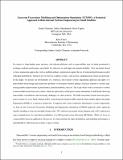| dc.contributor.author | Clements, Emily B | |
| dc.contributor.author | Mendenhall, Jeffrey A. | |
| dc.contributor.author | Caplan, David O. | |
| dc.contributor.author | Cahoy, Kerri | |
| dc.date.accessioned | 2020-03-10T14:16:16Z | |
| dc.date.available | 2020-03-10T14:16:16Z | |
| dc.date.issued | 2019-01 | |
| dc.identifier.issn | 2327-4123 | |
| dc.identifier.uri | https://hdl.handle.net/1721.1/124133 | |
| dc.description.abstract | In contrast to large-budget space missions, risk-tolerant platforms such as nanosatellites may be better positioned to exchange moderate performance uncertainty for reduced cost and improved manufacturability. New uncertainty-based systems engineering approaches such as multidisciplinary optimization require the use of integrated performance models with input distributions, which do not yet exist for complex systems, such as laser communications (lasercom) payloads. In this paper, we present our development of a statistical, risk-tolerant systems engineering approach and apply it to nanosatellite-based design and architecture problems to investigate whether adding a statistical element to systems engineering enables improvements in performance, manufacturability, and cost. The scope of this work is restricted to a subset of nanosatellite-based lasercom systems, which are particularly useful given current momentum to field Earth-observing nanosatellite constellations and increasing challenges for data retrieval. We build uncertainty-based lasercom performance models for a low Earth orbiting (LEO) system being developed at MIT called the Nanosatellite Optical Downlink Experiment (NODE) as a reference architecture. Compared with a more traditional, deterministic systems engineering,we find our new Lasercom Uncertainty Modeling and Optimization Simulation (LUMOS) approach yields significant benefits including a lasercom downlink design with a 59% reduction in ground station diameter and a 46% reduction in space terminal power for equivalent probabilities of a LEO-ground system delivering 500 Gb/day. While we focus on a nanosatellite lasercom application, the process for characterizing the input distributions and modeling performance is generalizable to other lasercom systems or space systems. | en_US |
| dc.publisher | A. Deepak Publishing | en_US |
| dc.relation.isversionof | https://jossonline.com/letters/lasercom-uncertainty-modeling-and-optimization-simulation-lumos-a-statistical-approach-to-risk-tolerant-systems-engineering-for-small-satellites/ | en_US |
| dc.rights | Creative Commons Attribution-Noncommercial-Share Alike | en_US |
| dc.rights.uri | http://creativecommons.org/licenses/by-nc-sa/4.0/ | en_US |
| dc.source | Prof. Cahoy via Barbara Williams | en_US |
| dc.title | Lasercom Uncertainty Modeling and Optimization Simulation (LUMOS): a Statistical Approach to Risk-tolerant Systems Engineering for Small Satellites | en_US |
| dc.type | Article | en_US |
| dc.identifier.citation | Clements, E. et al. (2019): JoSS, Vol. 8, No. 1, pp. 815-836 | en_US |
| dc.contributor.department | Lincoln Laboratory | en_US |
| dc.contributor.department | Massachusetts Institute of Technology. Department of Aeronautics and Astronautics | en_US |
| dc.relation.journal | Journal of Small Satellites | en_US |
| dc.eprint.version | Author's final manuscript | en_US |
| dc.type.uri | http://purl.org/eprint/type/JournalArticle | en_US |
| eprint.status | http://purl.org/eprint/status/PeerReviewed | en_US |
| dspace.date.submission | 2019-08-02T18:18:25Z | |
| mit.journal.volume | 8 | en_US |
| mit.journal.issue | 1 | en_US |
| mit.license | OPEN_ACCESS_POLICY | |
| mit.metadata.status | Complete | |
